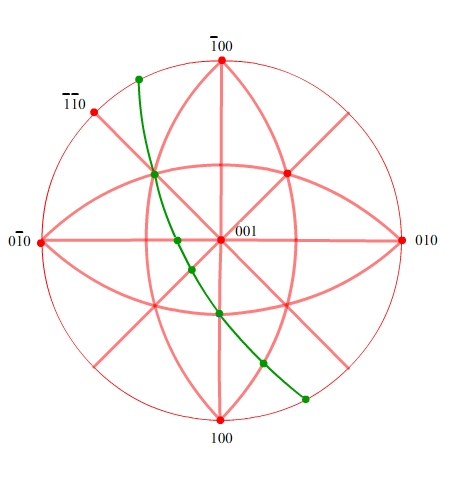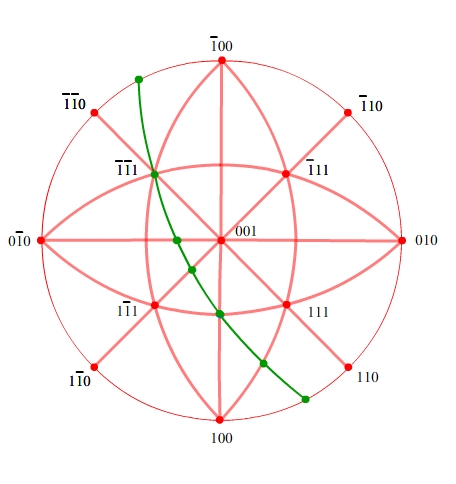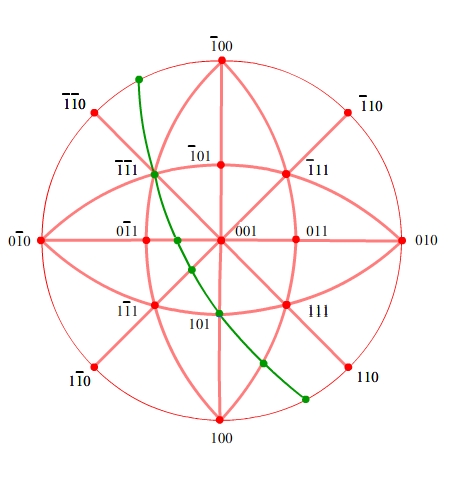NonCommercial-ShareAlike 4.0 International
https://creativecommons.org/licenses/by-nc-sa/4.0/
Identifying poles and vector addition
If a and b are any two vectors
in a plane, all other vectors lying in the plane are linear combinations
of a and b, i.e. of the form
r = αa
+ βb
where α and β
are numbers which are not necessarily integers
We can apply this system to the stereogram, by considering a great circle. This represents a plane in the material being examined. If we know the identity of poles in the great circle, we can find other poles in the great circle by linear addition.

On this stereogram, the poles we already know are identified. There are a number of poles added that we don't know, designated with letters.

The identity of these poles can be found through the principle of vector addition just discussed. For example, 'b' is roughly half way between 001 and 0 on the Wulff net.

We might suppose that pole 'b' is composed of one unit of 0 and one unit of 001, giving its identity as 1. This is indeed the case, as can be proved by the intersection of great circles. It is therefore identified.

It is useful to plot other poles on the stereogram that are helpful for identification of unknown poles. These have been identified previously, and so can be added without difficulty.

We can now identify 'e', by the addition of 001 and 100, as 101.

Other poles of the same form as 101 can be added.

'c' can be identified as a sum of 01 and 001. This means it could be 02, 03, 04 and others in that style. It is useful to have some more information. Since we know 'c' is in the green zone, it may be useful to identify that zone.

We've already identified two poles in the zone, so we have enough information to identify the zone itself. The poles in the zone are 101 and 1. We find the zone using the Weiss zone law.

1 0 1
−1 −1 1
i value: (0 x 1) − (1 x −1) = 1
j value: (1 x −1) − (1 x −1) = −2
k value: (1 x −1) − (0 x −1) = −1
The zone is therefore [1] or [21].

The pole 'c' is of the form hkl, but as we now know
the zone, certain restrictions can be imposed on the plane. For the
zone [21], using the Weiss zone law, we know:
- h + 2k + l =0

As the poles are potentially
02, 03, 04,
we can use the Weiss zone law already found to identify the plane. Comparing
the various planes to:
− h + 2k + l = 0
allows us to see that
the plane 02 fits, with:
− (0 x 1) + (2 x −1) + 2 = 0.
We have therefore identified 'c'.

'd' is a sum of 001 and 11, so it could be: 12, 13, 14 etc. However, it has to lie in [21]. Therefore, we can identify the plane 'd' as 13.

'a' and 'g' both sit on the primitive circle, and are therefore in the [001] zone. This means that they take the form hk0. With the constraint that they are also in the [21] zone, it is easy to realise that they will be of the form 2h,h,0.

'a' is between 00 and 0,
and so is obviously 0.
'g' is between 110 and 100, and so is obviously 210.
It can be noted that 'g' is diametrically opposite to 'a', and so is
of the opposite sense to 'a'.

We have now identified 'e' and 'g', and so we can find 'f', as it is a linear sum of 'e' and 'g'. As a sum of 101 and 210, there are various possibilities: 311, 412, 521, etc. However, since the indices of the plane have to be a linear combination of 100 and 111, we can identify 'f' as 311.

This principle of identification can be applied to any system given enough time.